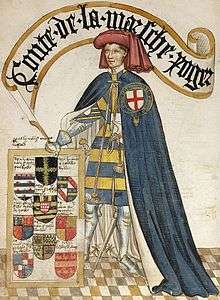Thomas Mortimer
Sir Thomas Mortimer (c.1350-1403) was an English soldier, statesman and judge of the late fourteenth century who served briefly as Lord Deputy of Ireland and Lord Chief Justice of Ireland. He is remembered chiefly for his killing of Sir Thomas Molineux, the royal commander at the Battle of Radcot Bridge, a crime which ultimately led to his conviction for treason and death in exile.
Background

He was an illegitimate son of Roger Mortimer, 2nd Earl of March. He seems to have been treated by his father and brother very much as one of the family. Nothing seems to be known of his mother. By 1380 he had acquired considerable military expertise, and had been knighted. When his legtitmate brother Edmund Mortimer, 3rd Earl of March was made Lord Lieutenant of Ireland in 1379, Thomas went with him to Ireland and acted as his Deputy, holding in his name a Great Council at Clonmel.[1] Edmund was charged with the task of subduing the Gaelic clans in Ulster and Munster, but had only limited success in this.
Lord Deputy of Ireland
Edmund's sudden death in December 1381 left the Dublin Government in a quandary, since there were very few men willing to assume the office of Lord Lieutenant, at a time of exceptional political turbulence in Ireland. Richard Wyre, Bishop of Cloyne, proposed that Thomas Mortimer should be appointed Lord Lieutenant, both for his military experience and his ability to retain the loyalty of his brother's retinue.[2] In the event King Richard II appointed Thomas's nephew, Roger Mortimer, 4th Earl of March, a child of seven, as Lord Lieutenant. The absurdity of this choice was lessened to some extent by the appointment of Thomas as Lord Deputy and Lord Chief Justice.[3]
Return to England
On the appointment of Sir Philip Courtenay as Lord Lieutenant of Ireland in February 1383, Thomas returned to England. His nephew's wardship had been entrusted to a group of magnates which included Richard FitzAlan, 11th Earl of Arundel, of whom Thomas was an intimate friend. It was evidently Arundel who appointed Thomas to the position of steward of the Mortimer estates during Roger's minority, thus greatly enhancing his status.[4] As Roger grew older he and his uncle became close, going hunting together and exchanging gifts of wine: Dunn suggests that Thomas was the closest Roger ever knew to a father.[5]
The Appellants
Arundel was a key member of the group of magnates called the Lords Appellant, who had emerged as opponents of Richard II and the royal favourite Robert de Vere, Duke of Ireland. Mortimer was closely associated with them and is known to have visited Arundel's house regularly during 1387, the critical year in the Appellants rise to power..
The Battle of Radcot Bridge
See main article: Battle of Radcot Bridge
In December 1387, at Radcot Bridge, the Appellants clashed with the royal army, headed by Robert de Vere and Sir Thomas Molineux, Constable of Chester Castle; de Vere was defeated and forced to flee. Mortimer himself killed Molineux, one of the few casualties of the fight.[6] According to Holinshed, Molineux, who had attempted to flee, pleaded for his life, but Mortimer pulled off Molinuex's helmet and stabbed him in the head with a dagger.[7]

During the brief rule of the Appellants, Mortimer was in high favour. He was appointed Justiciar of Ireland, but Richard, despite his temporary loss of power, somehow managed to countermand the appointment (no doubt he feared to surrender control of Ireland entirely to his enemies) and it never took effect. Despite their mutual mistrust, Thomas and his nephew Roger, with troops, accompanied the King on his Irish expedition in 1394;[8] and when Roger was reappointed Lord Lieutenant in 1396, Thomas went to Ireland with him.
Downfall
In 1397 the King at last moved to destroy the surviving Lords Appellant. Arundel, Mortimer's patron, was convicted of treason and executed. Mortimer was "appealed for" (i.e. charged with) treason, in that his killing of Molineux, the King's commander, ten years earlier was deemed in law to be an attempt to murder the King himself. Mortimer was not permitted to stand trial, but ordered to surrender himself within three months. Unsurprisingly Mortimer instead chose to flee the country: the King accused Roger, probably with good reason, of conniving at his uncle's escape.[9] Thomas was declared a traitor and his lands were forfeited to the Crown. He fled to Scotland where he died early in 1403.
Marriage
He married Agnes de Poynings, daughter of Michael de Poynings, 2nd Baron Poynings and his wife Joan Ruxley (or Rokesley), and widow of William Bardolf, 4th Baron Bardolf: they had no children.
Character
Although the details (if they were accurately reported) of his killing of Molineux seem to show him in a rather sinister light, Mortimer had the respect and esteem of many who knew him, including his brother and his nephew. The chronicler Adam of Usk, who knew him personally, praised him as "a vigorous knight".[10]
References
- ↑ Otway-Ruthven, A.J. History of Medieval Ireland Barnes and Noble Reissue 1993 p.315
- ↑ Otway-Ruthven pp.315-6
- ↑ Otway-Ruthven p.316
- ↑ Dunn, Alistair Richard II and the Mortimer Inheritance in "Fourteenth-century England" Given-Wilson ed. Boydell Press 2002 p.162
- ↑ Dunn p.164
- ↑ Dunn p.162
- ↑ Holinshed's Chronicles
- ↑ Otway-Ruthven p. 326
- ↑ Otway-Ruthven p.337
- ↑ Dunn p.164
| Legal offices | ||
|---|---|---|
| Preceded by John Keppock |
Lord Chief Justice of the King's Bench for Ireland 1382-1384 |
Succeeded by John de Sotheron |